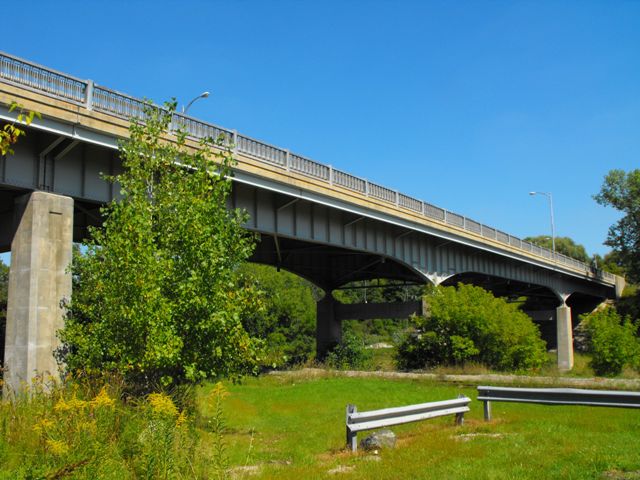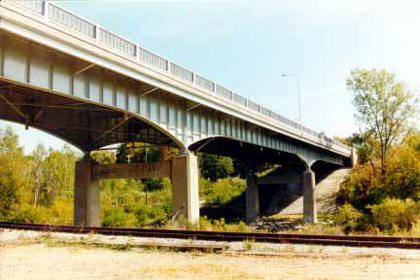We Recommend:
Bach Steel - Experts at historic truss bridge restoration.
BridgeHunter.com Phase 1 is released to the public! - Visit Now
Belding Bridge
Veterans Memorial Bridge

Primary Photographer(s): Nathan Holth
Bridge Documented: March 7, 2006, September 3, 2009, and April 23, 2022
M-44 / M-91 (Belding Road / State Street) Over Flat River / Mid-Michigan Railroad
Belding: Ionia County, Michigan: United States
1950 By Builder/Contractor: L. A. Davidson of Saginaw, Michigan
1998
130.0 Feet (39.6 Meters)
414.0 Feet (126.2 Meters)
28 Feet (8.53 Meters)
4 Main Span(s)
34134081000R010

View Information About HSR Ratings
Bridge Documentation
View Archived National Bridge Inventory Report - Has Additional Details and Evaluation
This bridge could also be referred to as the "M-44 / M-91 Bridge" as it carries both facilities over the Flat River and the Mid-Michigan Railroad. The Mid-Michigan Railroad was originally the Chesapeake and Ohio Railway Company. The road that carries M-44 and M-91 signage is named State Street in town, and is known as Belding Road outside of town.
This bridge is similar to the I-69 / I-94 Bridge in Port Huron. Not only do both bridges have the insignificant relationship that they carry a cosigned highway over multiple features below, they are significantly related in that both are cantilevered deck plate girder bridges. The Belding Bridge has a greater deal of historic integrity however and is perhaps a glimpse at what the Port Huron structure might have once looked like.
This bridge has been repaired/restored in recent years. MDOT took into consideration the historic nature of this bridge, because they were sure to keep the panels of the original railing on the bridge, rather than removing them completely. They removed the original guardrail posts and placed modern metal posts in. These posts hold the modern steel railings up on the road side. Behind the modern railings, the original guardrail panels were mounted in between each post. As a result, the bridge retains its same general appearance especially when viewed from a distance. The bridge deck was also redone. Corrugated steel forms the base, with concrete on top. The superstructure of the bridge was painted grey.
Information and Findings From Michigan Historic Bridge Inventory
Narrative Description This multiple-span concrete/steel bridge crosses over the Flat River and the Railroad tracks for the Chesapeake and Ohio Railway Company. Located in the village of Belding, the structure carries Highway M-44. It was dedicated in 1950 as the Veterans Memorial Bridge. Extending a total of 414 feet. The structure is made up of four steel girder spans that cantilever over the piers to form alternating anchor and suspended spans. These are supported by cast steel bearing shoes that rest on concrete abutments and spill-through piers. The abutments have stepped concrete wingwalls; the spill-through piers feature battered columns with modest recessed panels and straight cross-beams. The variable-depth, deck girders (two per span) are made up of steel plate webs, with riveted angle flanges and web stiffeners. They are braced laterally by crossed steel angles. The girders support and asphalt-covered, concrete deck with pedestrian walkways on both sides. Flanking the walkways are MSHD standard, decorative steel guardrails with concrete bulkheads and posts. In physically good condition, the Veterans Memorial Bridge has functioned in place since its completion with only maintenance-related repairs. By the late 1940s the existing Belding Road bridge over the Flat River in Belding had become a serious bottleneck to traffic. In 1949 engineers for the Michigan State Highway Department designed a replacement structure. MSHD designated the bridge a Federal Aid Secondary project, solicited competitive bids for its construction and awarded the contract to L.A. Davidson. Davidson completed the Flat River Bridge the next year for $258,929.47. This cost was divided among the Bureau of Public Roads, the Michigan State highway Department and the C&O Railroad. Built soon after the end of World War II, it was dedicated as the Veterans Memorial Bridge to the war veterans of Belding and vicinity on October 28, 1950. Since then it has carried vehicular traffic in essentially unaltered condition. The bridge's steel girder configuration is one that MSHD used extensively for bridges in the 1930s and 1940s. Although the highway department had delineated a standard steel stringer design as early as the 1905-1906 biennium, the relatively shallow I-beams that were being fabricated by the steel mills limited their span - first to30 feet, later to 45 feet. When the mills began producing deeper beams in the late 1920s, MSHD could extend the spans of its steel stringer bridges. When this type of structure was first put in use, MSHD state in 1930, rolled sections of sufficient strength were not available for spans greater than about forty-five feet. It was necessary, therefore, to use relatively shallow fabricated deck girders for spans greater that forty-five feet. Rather recently, however, steel mills have improved their methods and are able to furnish rolled section which on proper spacing, are suitable for spans up to sixty feet. For its long-span bridges in high-traffic locations, MSHD often substituted plate girders for rolled beams, and for its longest girder structures, it cantilevered the channel for spans from arms of the adjacent anchor spans. The Veterans Memorial Bridge in Ionia County is noteworthy among these cantilevered girder bridges for its relatively long span and its well-preserved condition. A locally prominent landmark, it is both historically and technologically significant. |
This bridge is tagged with the following special condition(s): Unorganized Photos
![]()
Photo Galleries and Videos: Belding Bridge
Bridge Photo-Documentation
A collection of overview and detail photos. This photo gallery contains a combination of Original Size photos and Mobile Optimized photos in a touch-friendly popup viewer.Alternatively, Browse Without Using Viewer
![]()
Additional Unorganized Photos
Original / Full Size PhotosA supplemental collection of photos that are from additional visit(s) to the bridge and have not been organized or captioned. This gallery offers photos in the highest available resolution and file size in a touch-friendly popup viewer.
Alternatively, Browse Without Using Viewer
![]()
Additional Unorganized Photos
Mobile Optimized PhotosA supplemental collection of photos that are from additional visit(s) to the bridge and have not been organized or captioned. This gallery features data-friendly, fast-loading photos in a touch-friendly popup viewer.
Alternatively, Browse Without Using Viewer
![]()
Maps and Links: Belding Bridge
Coordinates (Latitude, Longitude):
Search For Additional Bridge Listings:
Bridgehunter.com: View listed bridges within 0.5 miles (0.8 kilometers) of this bridge.
Bridgehunter.com: View listed bridges within 10 miles (16 kilometers) of this bridge.
Additional Maps:
Google Streetview (If Available)
GeoHack (Additional Links and Coordinates)
Apple Maps (Via DuckDuckGo Search)
Apple Maps (Apple devices only)
Android: Open Location In Your Map or GPS App
Flickr Gallery (Find Nearby Photos)
Wikimedia Commons (Find Nearby Photos)
Directions Via Sygic For Android
Directions Via Sygic For iOS and Android Dolphin Browser
USGS National Map (United States Only)
Historical USGS Topo Maps (United States Only)
Historic Aerials (United States Only)
CalTopo Maps (United States Only)



